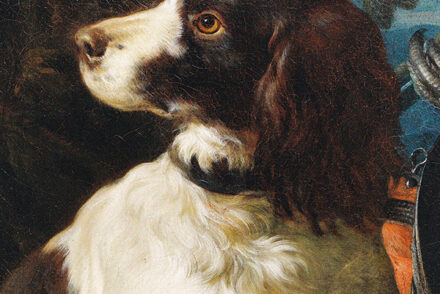‘Right’ and ‘wrong’ can be close together
In the Telling History section, we dive into Tilburg University’s rich Heritage Collections. This time Joep van Gennip, Program Manager University Heritage, talks about the illustrious career of Barend van Spaendonck and the suspicions there were of economic collaboration with the German occupiers.

At universities, honorary doctorates have long been awarded to individuals who have rendered service to society in a special way. Such is the case at Tilburg University, where Ms. Mariëtte Hamer received an honorary doctorate a few months ago “because of her special merits that were centered on serving the public interest.”
Our university’s predecessors also had this tradition. In 1947, for example, the first honorary doctorate at the Katholieke Economische Hoogeschool was awarded to the well-known socially committed priest Henri Poels, who, incidentally, already had a scientific doctorate in his pocket.
Catholic administrator
In 1956, the third honorary doctorate was presented at the still young Tilburg institution, and it was to the legal scholar Barend van Spaendonck (1896-1967), who was a prominent Catholic administrator and employer in the first half of the twentieth century. In addition, from its founding in 1927 until the 1960s, he was secretary of the Curatorium, the Executive Board at that time, of the Katholieke Economische Hoogeschool.
He was also a prominent member of the Katholieke Volkspartij, a member of the Social and Economic Council, founder of the Bureau Van Spaendonck for the secretarial support of the Tilburg textile industry, and director of the Rijksbureau voor Wol en Lompen (Netherlands Institute for Wool and Rags). Someone who had more than won his spurs, you might say.
Suspicions of collaboration with German occupier
Immediately after World War II, however, suspicions had arisen against him of economic collaboration with the German occupiers. Pending the investigation into this, the Dutch government had relieved him of all his public functions. The Katholieke Economische Hoogeschool, at that time not yet an institution financed by the state, adopted that decision, and suspended Van Spaendonck as secretary of the Curatorium.
This happened during the Curatorium meeting on May 1, 1945, a few days before the official liberation of our country. Since the Curatorium of the Tilburg R.K. Leergangen formed the same board as that of the Hogeschool, Van Spaendonck was also given notice there. However, with retention of salary.
On February 6, 1946, the judicial committee tasked with investigating his actions ruled that he was discharged from prosecution and could be restored to his public duties. The purge report underlying this stated that Mr. Van Spaendonck’s views were rather materialistically oriented. As a result, his opposition to the measures of the occupier […] expressed itself mainly there, where the material interests of the Dutch people in general and the interests of the (textile) industry in particular were at stake, while in other cases he adopted an opportunistic attitude where, on the contrary, a principled position of rejection would have been appropriate.
Uniforms of the police and fire departments
The latter specifically concerned the continuation of the supply of uniform cloth to the government, in this case the German occupying forces, as director of the aforementioned Rijksbureau voor Wol en Lompen. Van Spaendonck argued, correctly, that this cloth was also used for uniforms of the police and the fire department and thus (also) served the Dutch civilian interest.
However, the fact that he had had the quantity of cloth in the Netherlands inventoried for the occupying forces at the end of May 1940 was criticized in particular by the Tilburg textile manufacturer Henri Blomjous, who, as (vice-)president of the Curatorium of the Hogeschool, was, please note, Van Spaendonck’s closest colleague! He had therefore been heard by the inquiry committee. Furthermore, Van Spaendonck could be charged with having given a lecture to an industrial congress organized by the Germans in The Hague and having published something about it in a pro-German magazine.
Anti-German and very anti-social
Taken together, these were not the most serious offenses. Moreover, in October 1940, the NSB bureau had characterized him as anti-German, anti-National Socialist and very anti-social. Even the purification committee, in its 1946 report, had praised Van Spaendonck for staying on as director and thus serving the “Dutch interest.”
These things were not black (wrong) or white (right), but, in the words of historian Chris van der Heijden, rather a gray area. This ties in with Tilburg University’s digital war memorial in which students were asked, “What would you do?” during the war. Resistance, “collaboration,” accommodating, or nothing? And where are the boundaries between these areas? Poignant questions that are unfortunately still highly topical today, with the war in Ukraine.
Years of commitment
How this determined the further relationship between the two Tilburg Curatorium members is not known. By June 1946, Van Spaendonck had returned to his post as secretary of the Curatorium of the Hogeschool while Blomjous was still (vice-)president. The latter died in 1953. A few years later, in 1956, Bernard van Spaendonck retired as secretary of both Curatoria. Finally, at the end of that year, at the 29th Dies Natalis, he received an honorary doctorate from the Katholieke Economische Hoogeschool “for his extraordinary achievements in the social and economic fields”.
Unfortunately, the deliberations for awarding this honorary doctorate are missing from the university archives, but, according to the Nieuwsblad van het Zuiden, his great contribution to various forms of social and financial security for Tilburg textile workers certainly contributed to that positive decision. Undoubtedly also his many years of commitment to the Tilburg Hogeschool. “Right” and “wrong” can be close together.
Translated by Language Center, Riet Bettonviel






